INTRODUCTION
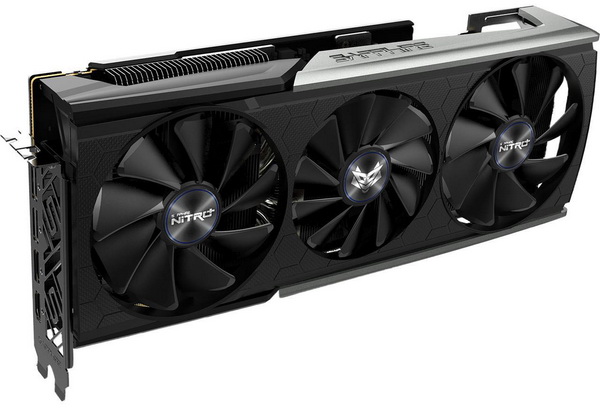
One of the things that brings out the best (and the worst sometimes) the electronics industry has to offer is competition and thanks to legendary rivalries like that between AMD and Intel and ATI and NVIDIA (AMD and NVIDIA now) there's been a staggering amount of technological leaps in their respected fields over the years and far beyond what anyone thought possible (in this small timeframe that is). For gamers of course the rivalry between ATI/AMD and NVIDIA has clearly "produced" the most "benefits" since today we have graphics cards capable of rendering games in 4k resolution and above with a plethora of graphical enhancements and at impressive frame rates. The Radeon RX 5700 XT is the latest flagship gaming graphics card by AMD and after high demand by many of our readers today I’ll be testing one of the best custom design cards based on it, the Nitro+ (Plus) model by Sapphire.
SAPPHIRE Technology continues to be a world leading manufacturer and global supplier of innovative graphics and mainboard products, delivering its AMD Radeon based products to the PC markets addressing gaming, eSports and performance graphics enthusiasts as well as delivering an array of professional graphics products and embedded system solutions. Recently SAPPHIRE has penetrated new markets with a series of GPU Compute server systems targeting the blockchain and commercial cryptocurrency mining businesses.
The RX 5700 XT was released by AMD last July and is based on the latest Navi 10 (codename) silicon (manufactured at TSMC with a 7nm process) which supports the new PCIe Gen 4.0 x16 interface/bus and features their latest RDNA SIMD architecture (which according to AMD sports an 25% IPC gain over GCN). When it comes to numbers the new Navi 10 silicon sports a total of 10.3 billion transistors and features 2560 stream processors (shader units), 160 TMUs (texture mapping units) and 64 ROPs (raster operations pipelines). The Radeon RX 5700 XT cards are also equipped with 256-bit 8GB GDDR6 memory at frequencies of 14Gbps (resulting in a bandwidth of no less than 448GB/s) and video outputs that support resolutions all the way up to 8K at 60Hz, 4k at 240Hz and FHD at 360Hz over single cables. As expected however the Radeon RX 5700 XT Nitro+ by Sapphire takes things many steps further compared to the vanilla version by using higher clocks (2010MHZ Boost/1905MHZ Gaming/1770MHZ Base) and adding several features such as an top of the line tri-fan cooling system (offers superior VRM and memory cooling), fuse protection for the PCI-E power connectors, black diamond chokes, dual-BIOS, ARGB lighting (3 zones) and an aluminum backplate. No wonder this is considered one of the best Radeon RX 5700 XT cards in the market today right?
SPECIFICATIONS AND FEATURES

PACKAGING AND CONTENTS
Sapphire ships the card inside a blue, gray and black box that has their logo at the front along with the main product features.
A sticker with the cards serial numbers and barcodes is located on the left side.
The product features are all printed at the rear of the box right over the system requirements and next to a few words about the card itself.
Packaging is pretty much perfect with the card being wrapped inside a thick plastic static-free bag and placed inside a piece of black foam.
Not much in terms of bundle since along with the Radeon RX 5700 XT Nitro+ you will only get a small paper with the company and distributor contact information, a large paper pointing to the ARGB sync feature of the card and the quick start guide.
THE RADEON RX 5700 XT NITRO+
The Sapphire Radeon RX 5700 XT Nitro+ is a beast of a card that measures no less than 306mm in length, 49mm in width (effectively uses 3 slots) and 135mm in height.
Sapphire has equipped the card with a tri-fan system that uses dual-ball bearing fans which spin both clockwise (small center fan) and counter-clockwise (left and right larger fans) to produce optimal airflow levels.
Two of the three ARGB zones are located at the top of the card, one is right beneath the company logo/name and the other is the LED bar placed next to it.
By using two 8pin power connectors the Radeon RX 5700 XT Nitro+ can draw up to 375W.
Since the new Navi 10 silicon does not support crossfire Sapphire has used that area to place the dual-BIOS switch.
As you can all see the rear aluminum backplate doesn't cover the entire area but it looks nice (the Sapphire Nitro+ is the 3rd and last ARGB zone).
This small three-pin connector allows you to plug your RGB mainboard with the card to sync their LEDs (unfortunately Sapphire doesn't bundle the require cable with the card).
At the front of the card we find two DisplayPort v1.4a and two HDMI v2.0b connectors.
In the above pictures you can see how the ARGB lighting looks when the card is powered on.
TRIXX V7.3
Sapphire released the latest version of their TRIXX software a few months back and as you can all see the dashboard tab gives you information on the card and its clocks and also allows you to change the BIOS without using the switch.
From the hardware monitor tab, you can check everything in regards to the card from the clocks and temperatures to the speed of the fans.
The TRIXX boost tab gives you the ability to improve overall performance by reducing the rendering resolution (it does work but in some cases the IQ drawbacks are quite visible). You can also enable sharpening from here (improves IQ at the cost of a tiny performance percentage).
You can check the state of the fans from the fan health check tab (gets quite noisy when testing the fans but could come in handy).
Unfortunately, even though the card has 3 ARGB zones you can’t control them individually from within the TRIXX software.
TEST BED
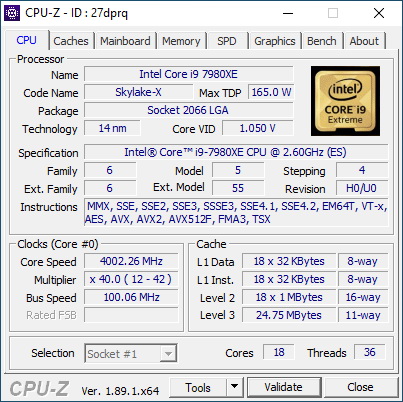

TESTING METHODOLOGY
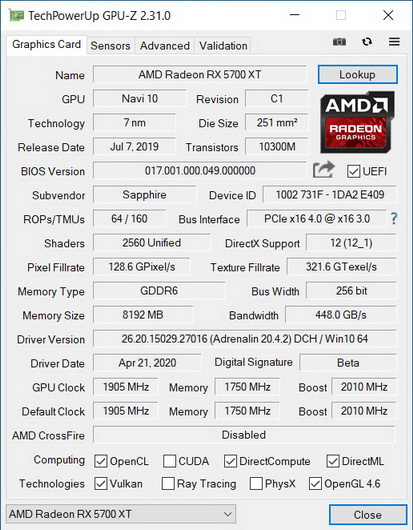
Since we'll be using our latest test rig with our graphics cards tests, we also moved to another screen (Philips BDM4037UW) in order to also offer 4k Ultra HD tests. Of course, 2160p (3840x2160p) is not the only resolution we'll be testing cards with, we are also going to be testing them at 1080p Full HD (1920x1080p) and 1440p (2560x1440p). Also because far too many gamers own Ultra-Wide screens at first i wanted to use our AOC AGON AG352UCG monitor in order to also have its resolution of 3440x1440p in our charts but since it's plugged into our other test rig several meters away from this one i really had to choose (and 4k seemed like the better choice). This time over we also updated the list of benchmarks/games to include the Time Spy benchmark by UL, Assassin's Creed Odyssey by Ubisoft, Devil May Cry 5 by Capcom, Dreadnought by Yager, GEARS 5 by The Coalition, Metro Exodus by 4A Games, Star Citizen by Cloud Imperium Games and The Outer Worlds by Obsidian Entertainment. As with the past options like power saving, sharpness and overlays are all disabled in the cards we’re testing (to achieve maximum performance) and all tests are repeated a total of 3 times in a fresh Windows 10 Pro installation with all updates installed until the day of our review (same as all the games used). Room temperature is as usual controlled and steady at 23 degrees Celsius for all tests and to record the temperatures of the cards we used AIDA64 and GPU-Z. Recording noise levels is done with an ExTech HD600 dBA meter from a distance of no more than half a meter away (exterior of case) while power consumption is measured again using GPU-Z.
TEST RESULTS - 3DMARK TIMESPY

Time Spy was added in 3DMark back in 2016 with only 1 simple goal, to test the graphics of systems with Windows 10 and DirectX 12. Time Spy was used at default settings.
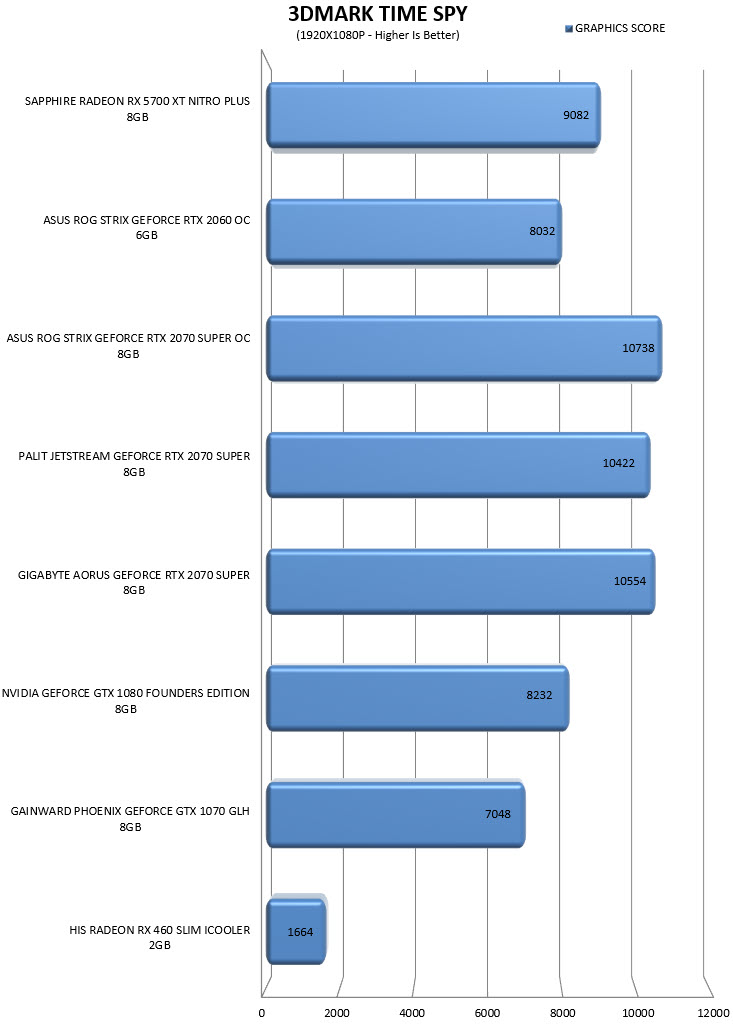


TEST RESULTS - ASSASSINS CREED ODYSSEY

Assassin's Creed Odyssey is an action role-playing video game set in the year 431 BC and the Peloponnesian War between Athens and Sparta and is based on the AnvilNext engine. For our tests we use the built-in benchmark of the game with FPS limit off, V-Sync off and the graphics set at high quality (because Assassins Creed Odyssey auto-detects your graphics card and sets settings accordingly the same graphics quality needs to be set manually every time).
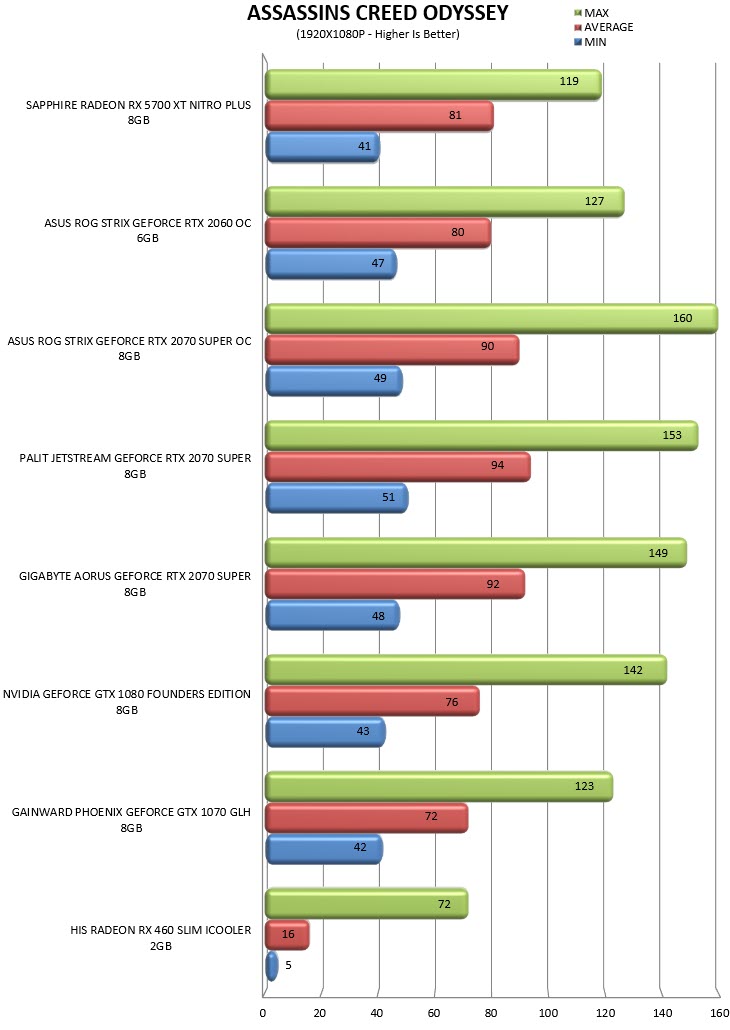


TEST RESULTS - BORDERLANDS 3

Borderlands 3 is an action role-playing first-person shooter video game released back in late 2019 and is powered by Unreal Engine 4. Borderlands 3 has a very basic built-in benchmark which we set at DirectX 12 with unlimited frame rate and overall quality set to High.



TEST RESULTS - DEVIL MAY CRY 5

Devil May Cry 5 is an action-adventure hack and slash video game released in March 2019 and is based on the RE Engine like other titles by Capcom. Devil May Cry 5 doesn't feature his very own built-in benchmark so for that purpose we're using the latest version of Rivatuner Statistics Server with V-Sync Off, variable frame rate and all graphics settings set at High.



TEST RESULTS - DREADNOUGHT

Dreadnought is a space combat simulation game released for the PC in late 2018 and is the 3rd game in our tests based on the Unreal Engine 4. Dreadnought used to come with its own built-in benchmark but since that was removed, we decided to use Rivatuner Statistics Server with V-Sync off and graphics set to High.



TEST RESULTS - GEARS 5

Gears 5 is a third-person shooter video game released back in mid-2019 and is powered by Unreal Engine 4 just like Borderlands 3. Gears 5 features a very convenient (not to mention fast) built-in benchmark which we use with V-Sync off, unlimited frame rate (none for minimum) and Ultra graphics quality.
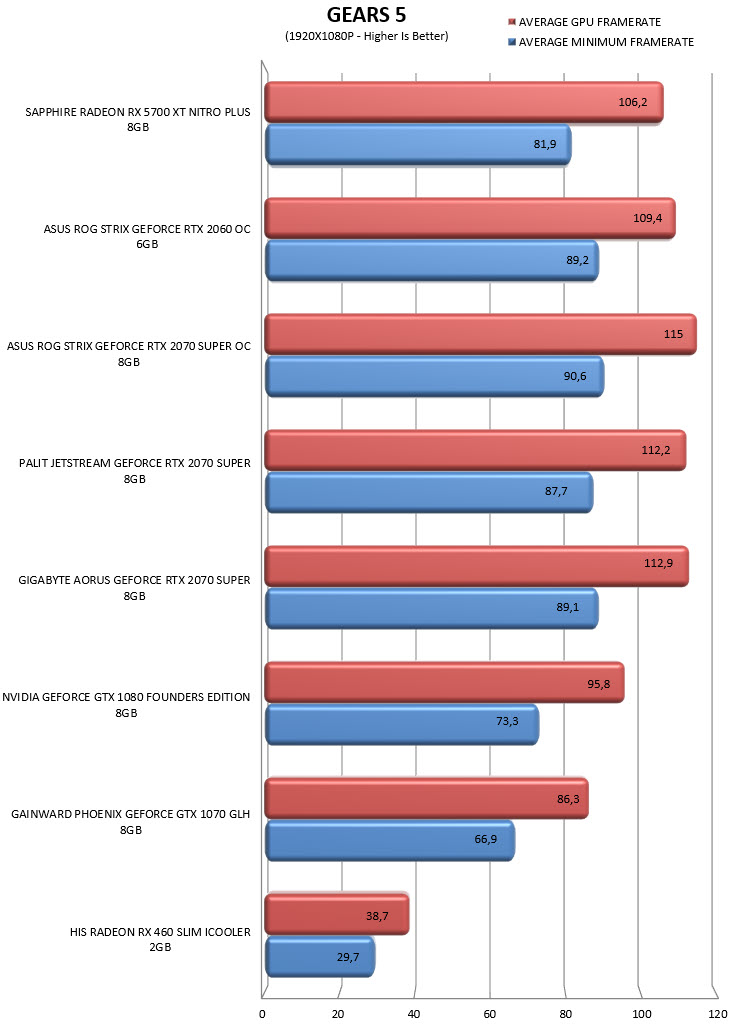


TEST RESULTS - METRO EXODUS

Metro Exodus is a first-person shooter video game released in 2019 and is based on the 4A Engine. The latest game in the Metro series also features its very own benchmark utility which we set at DirectX 12 and Ultra graphics quality (we're also running RTX tests with NVIDIA graphics cards with that setting set at Ultra).

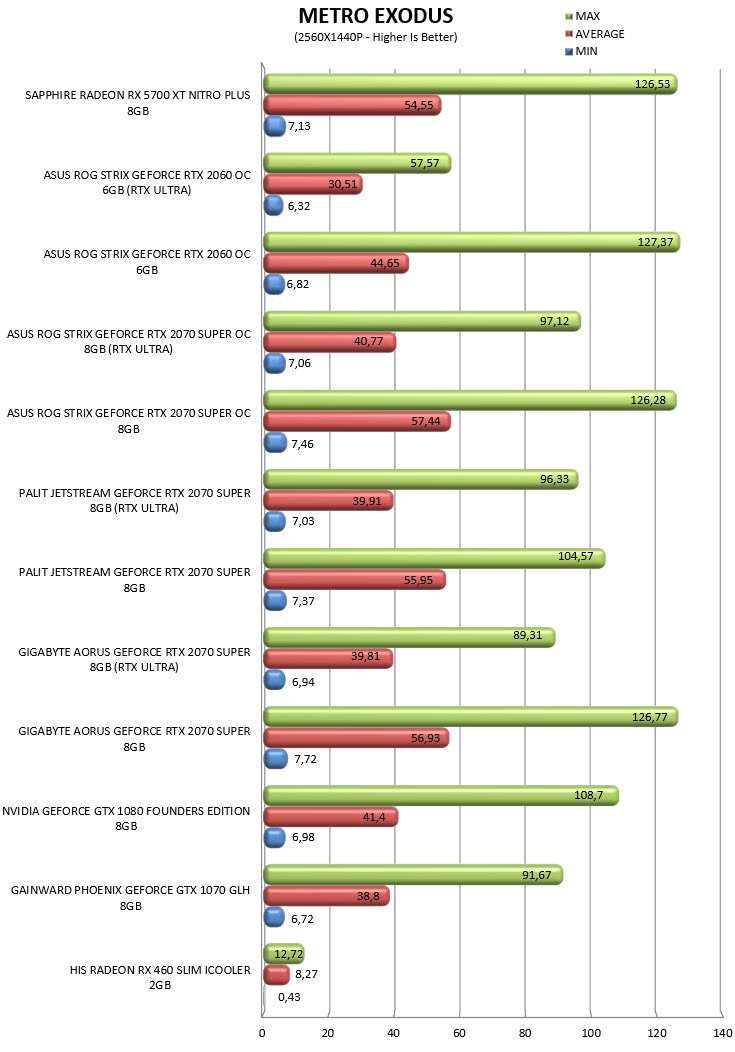
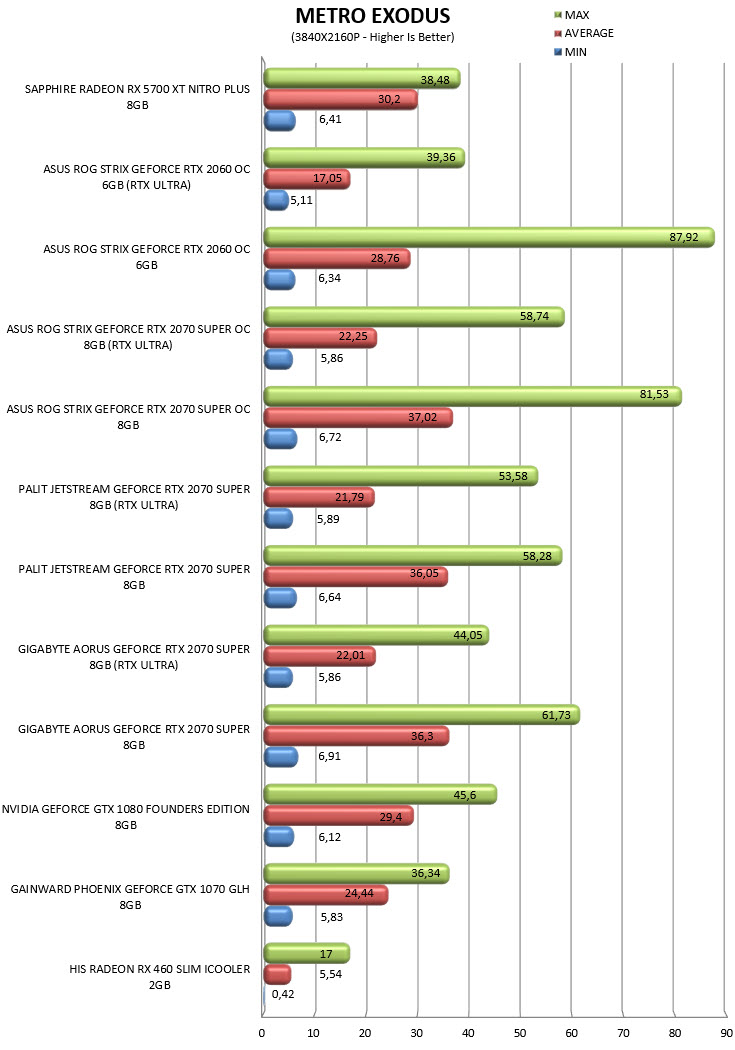
TEST RESULTS - STAR CITIZEN
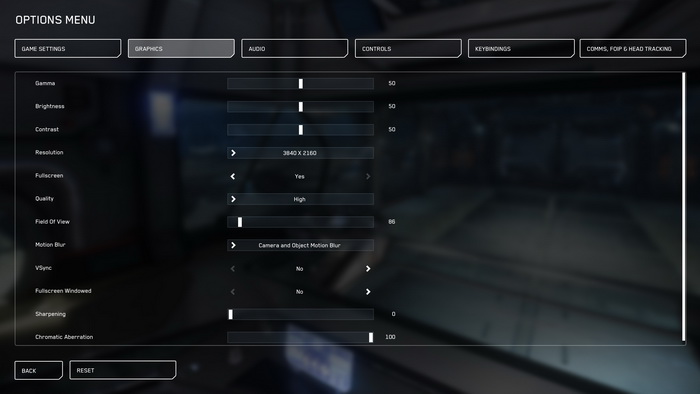
Star Citizen is an upcoming multiplayer space trading and combat game the main development of which started back in 2012 and is currently based on the Lumberyard game engine. Not only does Star Citizen come without any built-in benchmark (or utility) but it’s still in Alpha status meaning that this is not the most stable game title to use for our benchmarks (numerous graphics optimisations are expected between now and launch day). Still we wanted to have it in our charts for anyone interested and so we did by using Rivatuner Statistics Server with V-Sync turned off and the graphics set at High.



TEST RESULTS - THE OUTER WORLDS

The Outer Worlds is an action role-playing game released back in late 2019 and is also based on the Unreal Engine 4. The Outer Worlds is yet another title we had to use Rivatuner Statistics Server with V-Sync off, unlimited frame rate and graphics set at Very High.



TEST RESULTS - OVERCLOCKING
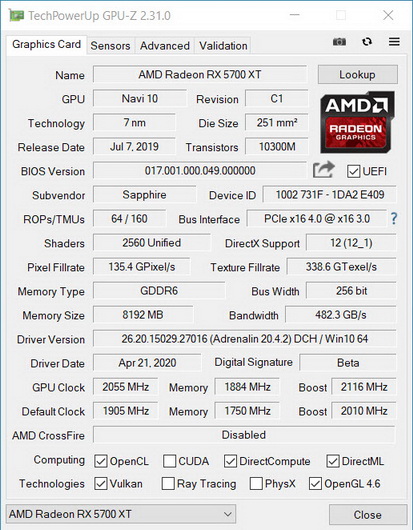
For this review we pushed the Radeon RX 5700 XT Nitro+ a total of 106MHz on the core (boost) and 134MHz on the memories (all the other cards in these charts are also overclocked).






TEST RESULTS - POWER CONSUMPTION / TEMPERATURES / NOISE LEVELS



CONCLUSION
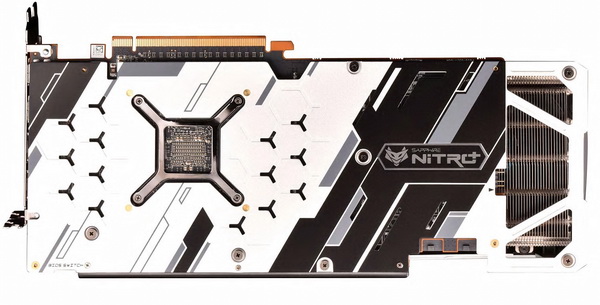
Four things one can take with him from today’s review, first that Sapphire doesn’t currently offer their very own overclocking software (not for this card - and the one in the AMD drivers which I had to use is far from ideal), second that this is indeed a very fast card (can almost match the performance of the more expensive GeForce RTX 2070 Super models), third that power consumption although higher than expected is still good and fourth that even the almost-excellent tri-fan system used with this model allows the card to run quite hot and loud (although certainly not as hot and as loud as previous models). The RGB feature also looks very nice, yes it would look even better if you had individual control over each of the 3 zones but even without that it still looks great. As for drivers even though lately both several media and even consumers have reported issues luckily, I didn’t encounter any so that too is a plus.
The Radeon RX 5700 XT Nitro+ 8GB by Sapphire currently retails for USD439 inside the USA (Amazon.com) and for 471.56Euros inside the EU (Amazon.de) a price tag which puts it right next to its closest competition, the GeForce RTX 2060 Super models. Worth pointing out is that Sapphire also has a special edition model of the Nitro+ with even higher clocks and ARGB fans for more demanding users (retails for roughly USD40/30Euros more – the fans can be purchased separately and mounted on this model as well). All said and done I have nothing negative to say about the Radeon RX 5700 XT Nitro+ 8GB graphics card by Sapphire since it delivers near excellent performance (especially for 1440p gaming), offers several image enhancements and the tri-fan cooler keeps it in check without getting too loud. For all of the above the Radeon RX 5700 XT Nitro+ 8GB gets our Golden Award.

PROS
- Build Quality (Backplate / Black Diamond Chokes / Fuse Protection)
- Very Good Performance
- Factory Overclock
- Dual BIOS
- Looks (3 Zone ARGB System)
- 8K 60Hz Video Output
- Supported Technologies (PCIe 4.0 / Image Sharpening / TRIXX Boost)
CONS
- Size (2.5 Slot Card / 3 Effective)
- TRIXX Software Doesn't Support Overclocking
- Noise Levels

 O-Sense
O-Sense





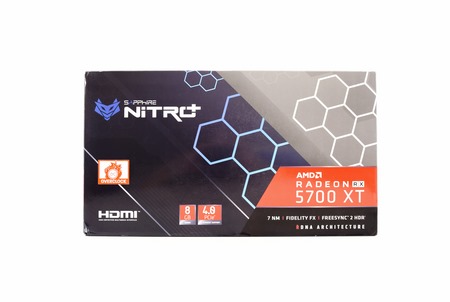














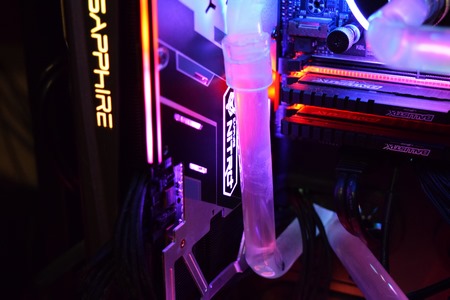

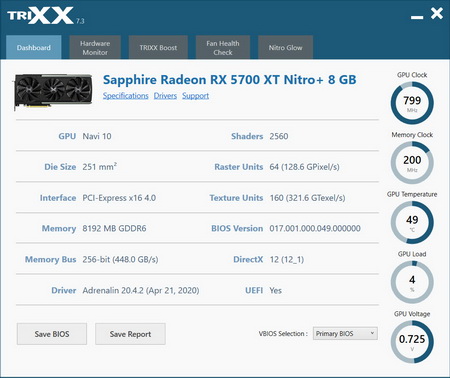

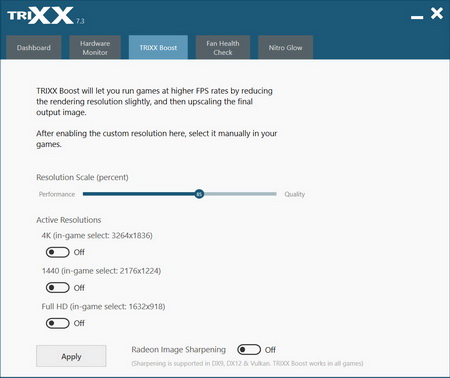




.png)

